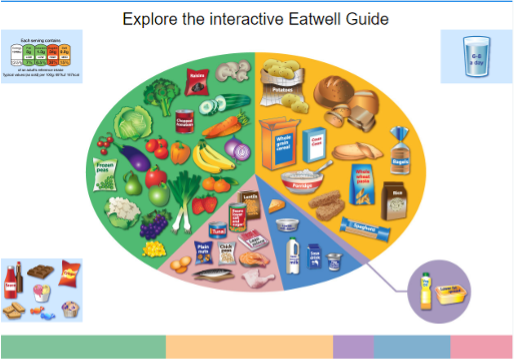Healthy Eating For All Ages
We all need to eat a good diet to keep us fuelled up with the energy we need for daily life, and the nutrients to help us fight infection and protect against health problems. But what exactly is a healthy diet?
The Department of Health has developed the ‘Eatwell’ plate to help.

It works for everyone over the age of five
The plate shows a diet that’s low in fat and high in fibre – what we should all be aiming for:
- Plenty of fruit and vegetables. We should eat at least five portions of a variety of fruit and vegetables each day. Fresh, frozen, canned, dried and juices all count – but remember, fruit juice only counts towards one portion, no matter how many glasses you have.
- Plenty of potatoes, bread, rice, pasta and other starchy foods. We should aim to get these types of foods into every main meal and sometimes also in snacks (around three or four portions per day). Go for wholegrain options like wholemeal bread, brown rice and whole wheat pasta when you can, as these contain more fibre and nutrients
- Some milk and dairy foods. We should have two or three portions of these each day. This includes the milk on your cereal, a yoghurt, the cheese in your sandwich or a pudding made from milk like rice pudding or custard
- Some meat, fish, eggs, beans and other non-dairy sources of protein. We should include around two portions of these foods in our diet each day. These foods are usually eaten at mealtimes: the chicken from a Sunday roast, minced beef in a spaghetti bolognaise, the salmon in a fish pie, the eggs in an omelette and the lentils in a vegetarian curry
- Just a small amount of foods and drinks high in fat or sugar. It’s ok to have these foods every now and again, but too often can lead to weight gain, an unhealthy heart and tooth decay.
Tips
- It doesn’t matter if you don’t manage this sort of balance every single day – think about the whole week
- Try to eat lots of different foods. The bigger the range, the better your balance of nutrients will be
- You can have pudding in a healthy diet! Pack them full of fruit, some milk, dairy or starchy food and not too much fat and sugar.
- It’s not just about what children eat – how they eat is important too.
Why each food group is important
Fruit and vegetables: for vitamin A and C, minerals like zinc and iron, and dietary fibre.
Potatoes, bread, rice, pasta, breakfast cereal and other starchy foods: for energy, carbohydrate, fibre and B vitamins. Breakfast cereals are often fortified with extra nutrients, but stick to those with a low or medium sugar content and avoid the chocolate-covered varieties
Milk and dairy foods: for energy, protein, calcium and vitamin A
Meat, fish, eggs, beans and other non-dairy sources of protein: for protein, iron and zinc. Oily fish is part of this group and is important because it provides omega 3 fatty acids, vitamin A and vitamin D.
Here are some great links to help at home and share with your child/children:
https://www.childrensfurniture.co.uk/tips-fussy-eaters
https://kids.kiddle.co/Healthy_diet
https://easyscienceforkids.com/what-is-healthy-food-for-your-body/

